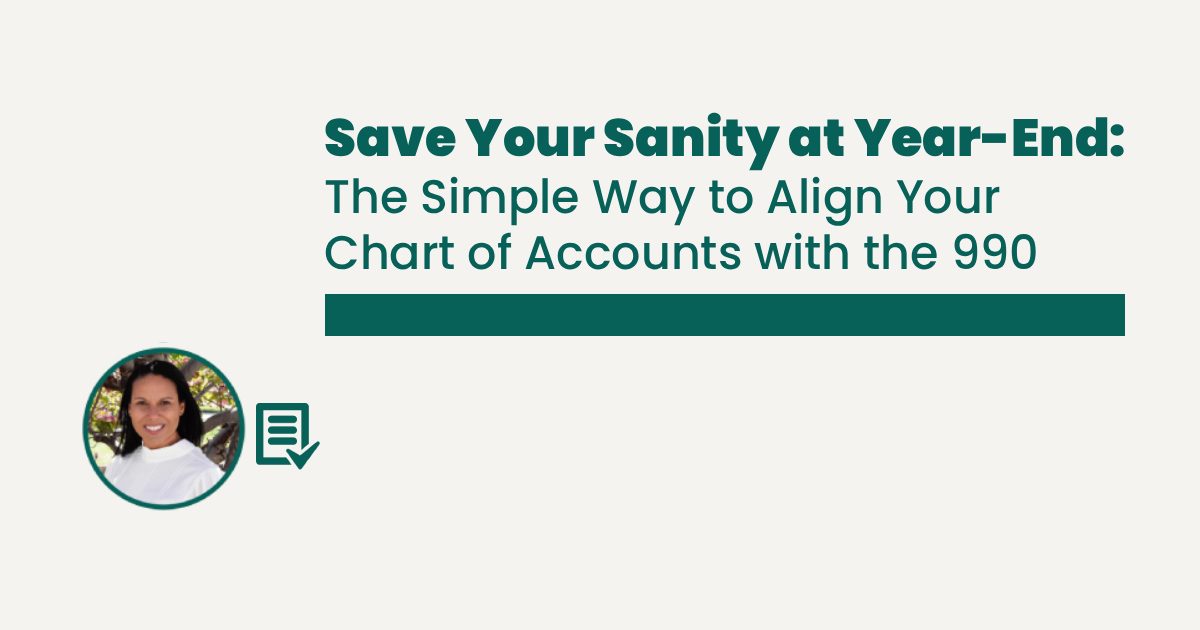Most small nonprofits don’t give much thought to how their Chart of Accounts (CoA) connects to the IRS Form 990 or 990-EZ — until tax time hits. Then, suddenly, all those vague categories like “Supplies,” “Miscellaneous,” and “General Expense” make preparing the return feel like solving a puzzle with missing pieces.
A little structure early on can make a big difference later. Aligning your CoA with the 990 doesn’t mean you need a giant overhaul — it just means setting things up so your books tell the same story your 990 will. The payoff is cleaner reports, easier audits, and less scrambling when it’s time to file.
>>> Next, let’s walk through how the 990 and 990-EZ are organized — and which parts actually connect to your bookkeeping.
Understanding the 990 and 990-EZ
The 990 series exists to keep nonprofits transparent about where their money comes from and how it’s used. The form you file depends on your organization’s annual gross receipts and total assets:
- Form 990-N (e-Postcard): for orgs with ≤ $50,000 in gross receipts (no detailed reporting required).
- Form 990-EZ: for orgs with less than $200,000 in receipts (e.g., donations + program fees) and less than $500,000 in assets (e.g., cash, equipment, property).
- Form 990: for orgs above those thresholds — the full version.
For our purposes, the key sections that tie directly to your bookkeeping are Parts VIII, IX, and X
| Section | What It Covers | Where It Connects in Your Books |
| Part VIII – Statement of Revenue | All sources of income — contributions, program service revenue, membership dues, investment income, gaming/fundraising income, and any other income | Your Income accounts. |
| Part IX – Statement of Functional Expenses | How funds were spent — grants and benefits paid out, salaries, professional fees, occupancy/rent expenses, utilities, maintenance, printing, publications, mailing expenses, and any other expenses | Your Expense accounts |
| Part X – Balance Sheet | Cash, savings, investments, land/buildings and other assets | Your Balance Sheet accounts |
The rest of the 990 focuses on governance, compliance, and activities, but these three sections form the financial backbone of your filing.
>>> Now that you know what each section covers, let’s connect it to your Chart of Accounts.
Organizing Your Chart of Accounts Around the 990
The goal isn’t to mirror the 990 line-for-line — it’s to build a Chart of Accounts that naturally rolls up into those key sections. Every nonprofit’s structure looks a little different, but this is how I like to set things up: simple, clear, and aligned with the way the 990 reports activity.
When your CoA follows the same logic as the 990, your reports practically organize themselves.
We’ll start with the Statement of Activity (Profit & Loss Statement), setting up contribution and expense accounts, and then move on to the Statement of Financial Position (your Balance Sheet).
Part VIII – Statement of Revenue
Revenue lines on the 990 start with contributions and move down through program income, investment income, and “other.”
Contributions
- Contributions –
- Unrestricted
- Individual Donations
- Corporate Donations
- Restricted
- Building Fund
- Scholarship Fund
- Grants
- Local Foundation Grant
- State Grant – Youth Program
- Unrestricted
- Program Service Revenue
- Membership Dues
- Tuition
- Fundraising Income
- Event Ticket Sales
- Silent Auction Proceeds
- Interest/Investment Income
Note: Grants are technically contributions, but they’re often tracked as sub-accounts under Restricted Contributions to separate structured funding (like foundation or government awards) from general donor gifts. The IRS reports them all together under “Contributions, Gifts, and Grants” on the 990, so this setup keeps your books practical and aligned
Part IX – Functional Expenses
This is the section where many nonprofits get tangled. The 990 asks organizations to show how their expenses support their mission by splitting them into functional categories — program, administrative, and fundraising. Setting up your Chart of Accounts with those categories in mind makes reporting easier later.
Expenses
- Program Expenses
- Supplies – Youth Program
- Contract Services – Tutoring
- Grants
- Benefits Paid
- Management/Admin Expenses
- Office Supplies
- Software Subscriptions
- Marketing
- Office Expenses
- Rent
- Utilities
- Maintenance
- Professional /Independent Contractor Fees*
- Fundraising Expenses
- Event Supplies
- Donor Mailings
Payroll is often one of the largest expenses for nonprofits, and the 990 calls for these costs to be reported separately within each functional area. That’s why it deserves its own section in your Chart of Accounts — to keep wages, taxes, and benefits organized and easy to map at year-end.
Keeping it separate — with sub-accounts for Program, Admin, and Fundraising staff — gives you flexibility to track by function without cluttering your reports. This approach also keeps things clean and leaves room to apply simple estimates later if staff split time between multiple areas.
Expenses with Payroll
- Program Expenses
- Supplies – Youth Program
- Contract Services – Tutoring
- Grants
- Benefits Paid
- Management/Admin Expenses
- Office Supplies
- Software Subscriptions
- Marketing
- Office Expenses
- Rent
- Utilities
- Maintenance
- Professional /Independent Contractor Fees
- Fundraising Expenses
- Event Supplies
- Donor Mailings
- Payroll
- Wages
- Program Staff
- Admin Staff
- Fundraising Staff
- Payroll Taxes
- Employee Benefits
- Wages
Part X – Assets & Liabilities
Your Statement of Financial Position (Balance Sheet) tells the story of what your nonprofit owns and owes. Group these accounts cleanly so they align with the 990’s Balance Sheet section.
Assets
- Checking – Operating
- Savings – Emergency Fund
- Investments – Fidelity EFTs
- Prepaid Expenses
- Building
- Equipment
Liabilities
- Credit Card – AmEx
- Loan – Community Bank
- Deferred Revenue – Summer Program
When your assets, income, and expenses mirror the 990’s flow, your reports become easier to read and your year-end prep becomes a routine task instead of a project. It’s the kind of structure that helps you stay compliant and manage day-to-day finances more confidently.
>>> Next, we’ll look at how to keep your Chart of Accounts aligned over time — with consistent naming, smart review habits, and a little restraint when adding new accounts.
Maintaining Consistency and Simplicity
Setting up your Chart of Accounts is only half the battle — keeping it clean is what saves you later. Over time, it’s easy for new accounts, duplicates, or “temporary” fixes to sneak in. Before you know it, your reports look more like a scavenger hunt than a financial summary. The key is to make your CoA work for you, not against you.
1. Keep Names Consistent
Decide early how you’ll name things — and stick with it. My thought: simple naming + subaccounts = cleaner reports and easier 990 prep.
Before:
- Program Supplies – Summer Camp
- Program Supplies – Youth Program
- Program Supplies – Tutoring
After:
- Program Supplies
- Summer Camp
- Youth Program
- Tutoring
2. Review and Trim Regularly
Once or twice a year, review your Chart of Accounts. Merge duplicates, archive unused accounts, and make sure new ones truly belong. If an account hasn’t had activity in 12 months, ask yourself why it’s still there.
3. Don’t Overcomplicate Subaccounts
Subaccounts are great — until they’re not. If you have to scroll to see the full list, it’s probably too long. Group only what helps with reporting and decision-making.
4. Schedule a Quick Monthly Check
Each month, glance through your accounts for any odd new additions or misclassifications. Fixing a few small issues now beats digging through “Miscellaneous Expense” six months from now.
5. Document Your Structure
If you’re not the only one handling the books, or you eventually hand them off, keep a short “Chart of Accounts Guide”. Just one or two pages listing your naming rules and account purposes can save hours of confusion later.
Clean books make for smoother reporting, clearer board communication, and less panic at tax time. Your CoA doesn’t need to be perfect — it just needs to be logical, consistent, and maintained.
>>> Next, we’ll wrap up with a few closing thoughts on creating alignment between your books and your mission.
Bringing It All Together
A well-structured Chart of Accounts isn’t about perfection — it’s about clarity. When your CoA mirrors the 990, your reports naturally fall into place. You’ll spend ess time reclassifying or guessing, and more time understanding your numbers. The goal is simple:
- organized enough for the 990,
- practical enough for the board, and
- straightforward enough that no one dreads opening QuickBooks.
If your setup reflects your real-world operations — programs, admin, fundraising, and payroll — you’re already ahead of most. And remember, this isn’t a one-time task. Review it once or twice a year, make small refinements, and let your CoA evolve with your organization. That steady attention pays off every time you need to report, plan, or explain where the money went. Because in the end, clean books don’t just make filing easier — they help your nonprofit tell a clearer financial story that supports the mission you’re working so hard to deliver.
Need a Little Help?
If your Chart of Accounts could use a second set of eyes —or you’d like to make sure your books align with your next 990 — I can help. Whether it’s a one-time review or a full setup, my goal is simple: make your financials make sense so you can stay focused on your mission.
That’s the kind of clarity that saves time, reduces stress, and keeps your nonprofit ready for whatever’s next.

